AMD FX-8320E CPU Review: The Other 95W Vishera
by Ian Cutress on January 13, 2015 10:00 AM ESTF1 2013
First up is F1 2013 by Codemasters. I am a big Formula 1 fan in my spare time, and nothing makes me happier than carving up the field in a Caterham, waving to the Red Bulls as I drive by (because I play on easy and take shortcuts). F1 2013 uses the EGO Engine, and like other Codemasters games ends up being very playable on old hardware quite easily. In order to beef up the benchmark a bit, we devised the following scenario for the benchmark mode: one lap of Spa-Francorchamps in the heavy wet, the benchmark follows Jenson Button in the McLaren who starts on the grid in 22nd place, with the field made up of 11 Williams cars, 5 Marussia and 5 Caterham in that order. This puts emphasis on the CPU to handle the AI in the wet, and allows for a good amount of overtaking during the automated benchmark. We test at 1920x1080 on Ultra graphical settings.
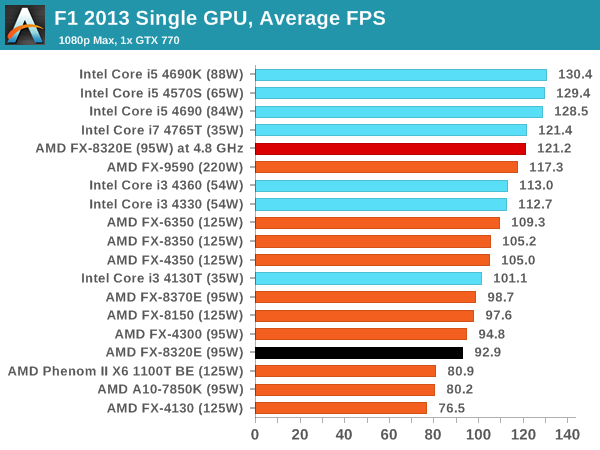
In both single and dual GPU cases, the stock performance of the FX-8320E falls behind the i3 CPUs by a 10-20 FPS margin, perhaps being noticeable on 120 Hz monitors. The minimum FPS on a single GPU still retains above 60 FPS, which is a plus.
Bioshock Infinite
Bioshock Infinite was Zero Punctuation’s Game of the Year for 2013, uses the Unreal Engine 3, and is designed to scale with both cores and graphical prowess. We test the benchmark using the Adrenaline benchmark tool and the Xtreme (1920x1080, Maximum) performance setting, noting down the average frame rates and the minimum frame rates.
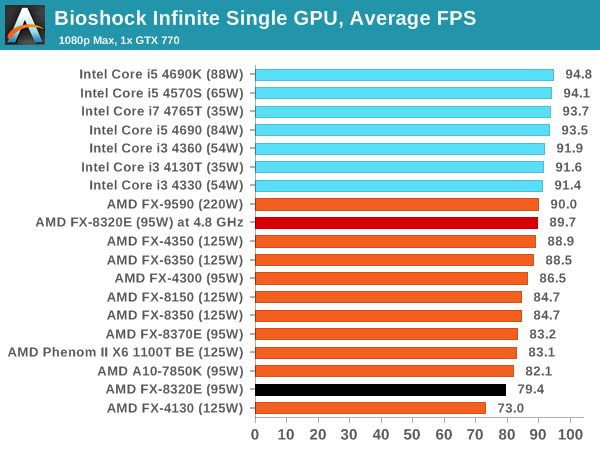
While average frame rates almost appear to be CPU agnostic, there is a clear AMD/Intel split here. More interesting is the minimum FPS results which seem to rely on IPC.
Tomb Raider
The next benchmark in our test is Tomb Raider. Tomb Raider is an AMD optimized game, lauded for its use of TressFX creating dynamic hair to increase the immersion in game. Tomb Raider uses a modified version of the Crystal Engine, and enjoys raw horsepower. We test the benchmark using the Adrenaline benchmark tool and the Xtreme (1920x1080, Maximum) performance setting, noting down the average frame rates and the minimum frame rates.
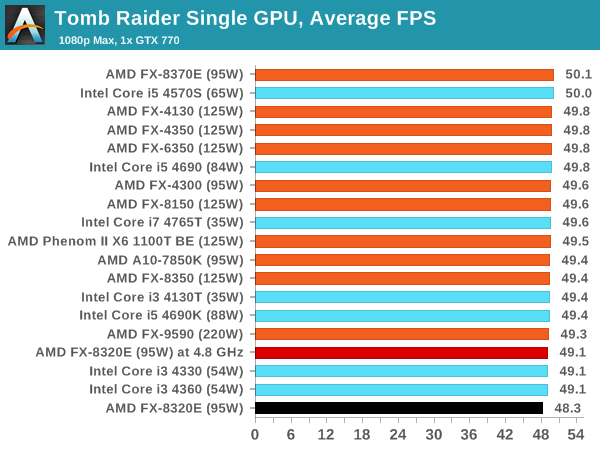
Tomb Raider still comes across as purely CPU agnostic.
Sleeping Dogs
Sleeping Dogs is a benchmarking wet dream – a highly complex benchmark that can bring the toughest setup and high resolutions down into single figures. Having an extreme SSAO setting can do that, but at the right settings Sleeping Dogs is highly playable and enjoyable. We run the basic benchmark program laid out in the Adrenaline benchmark tool, and the Xtreme (1920x1080, Maximum) performance setting, noting down the average frame rates and the minimum frame rates.
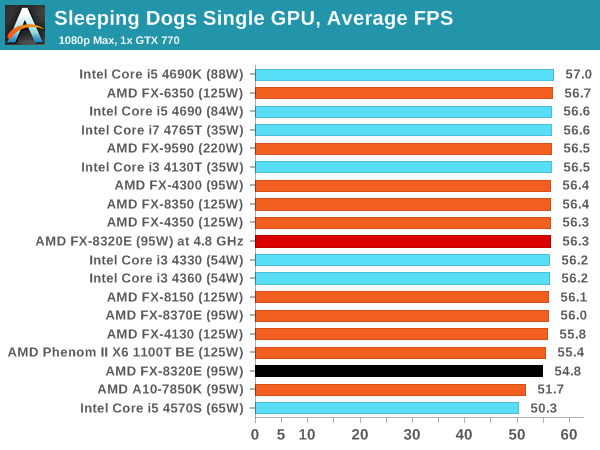
Single GPU usage puts the 8320E in the ballpark, but moving to dual GPUs sees an uplift in terms of the i5 CPUs for high refresh rate screens, albeit with the extra cost associated.
Battlefield 4
The EA/DICE series that has taken countless hours of my life away is back for another iteration, using the Frostbite 3 engine. AMD is also piling its resources into BF4 with the new Mantle API for developers, designed to cut the time required for the CPU to dispatch commands to the graphical sub-system. For our test we use the in-game benchmarking tools and record the frame time for the first ~70 seconds of the Tashgar single player mission, which is an on-rails generation of and rendering of objects and textures. We test at 1920x1080 at Ultra settings.
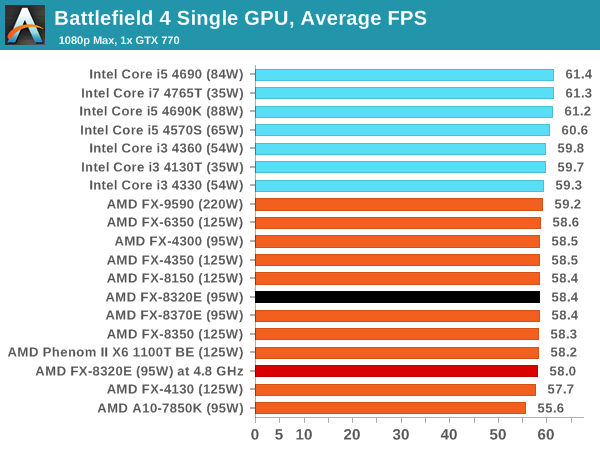
Single GPU shows little difference (despite a clear AMD/Intel separation line), but in dual GPU mode an i3 will make a 17 FPS rise, moving to 27 FPS with the i5 and more relevant to high refresh displays.















92 Comments
View All Comments
happycamperjack - Wednesday, January 14, 2015 - link
That's why I put "maybe". It's definitely not an ideal game to use for benchmark that's for sure.Zap - Wednesday, January 14, 2015 - link
Games that people are playing? You mean those super demanding ones like League of Legends and World of Warcraft, right? Because those two games have the lion's share of active gamers and actual game time right now. Since WoW's latest expansion came out, the two combined (using Raptr numbers) are 35% of the actual time spent in game for all PC gamers combined, trailed distantly by DotA2 at around 5% in 3rd place. "Demanding" games like BF4 can't even break the top 10, and barely exceed 1%.jabber - Thursday, January 15, 2015 - link
I would add the Sims to that very small list. The games I see installed on customers machines are actually pretty rare. In fact if you want to cover 90% of PC users then just include a Solitaire benchmark.dr_psy - Tuesday, January 13, 2015 - link
When are you people to stop that crappy "Power Consuption Delta" and come back to the raw values?This alone is reason enought to think in another webs to find reviews. Much more thes days when the power consuption values are so important. :(
hojnikb - Tuesday, January 13, 2015 - link
c'mon amd, update your damn chipsets. Having almost 6 year old chipsets (900 series is really nothing more than just a rebadge of 800 series) with no entery level option (like h81 with intel) is just sad for a platform that is suposibly aim at budget segment.Acreo Aeneas - Tuesday, January 13, 2015 - link
You do realize this is a article about a AMD CPU right? AMD CPUs are not compatible with Intel chipsets. Wish people would read the article before coming up with random commentry.hojnikb - Tuesday, January 13, 2015 - link
who was talking about compatability with intel chipsets ?I'm just pointing out, that amd has no budget chipset option (yeah, i'm not gonna cout 760G, since that stuff is literally ancient).
hojnikb - Tuesday, January 13, 2015 - link
>Wish people would read the article before coming up with random commentry.Same could be said for you.
silverblue - Tuesday, January 13, 2015 - link
That's not what (s)he said. The 970 isn't as budget as we'd like - it can be about twice the price of an H81 board - and they're still on 65nm fabrication which means slightly higher system power consumption. A refreshed chipset for FX may not make sense, but if they were to offer more USB 3.0 ports, PCIe 3.0 and - heaven forbid - a 32nm southbridge, and cutting the price down a little, an FX system would make a little more sense.hojnikb - Tuesday, January 13, 2015 - link
Exactly my point. You can grab a cheap h81 mobo and the cheapest i5 for around the same money as 8320 and 970 mobo. And with intel you get superior platform (even the cheapest chipset offers native usb3 and pcie3), power consumption and better single thread performance.These amds make little sense outside of very specific workload, where many bulldozer cores come in handy.